Unraveling the Enigma of Ctenophores: The Luminous Comb Jellies
Beneath the ocean's surface lies a world of bioluminescent wonder, where creatures of ethereal beauty and alien-like qualities captivate marine biologists and ocean enthusiasts alike. Among these fascinating organisms, ctenophores, commonly known as comb jellies, stand out as some of the most enigmatic and visually striking inhabitants of our planet's seas.

The Glowing Gelatinous Marvels
Ctenophores, derived from the Greek words for comb and bearer, are aptly named for their distinctive rows of cilia that resemble the teeth of a comb. These cilia, arranged in eight rows along the animal’s body, are responsible for both locomotion and the dazzling light display that has earned ctenophores their reputation as living rainbows of the sea.
Unlike their distant cousins, the jellyfish, ctenophores lack stinging cells and instead rely on sticky cells called colloblasts to capture their prey. This unique adaptation allows them to ensnare small organisms without causing harm to humans, making them a favorite subject for marine aquariums and public displays.
A Window into Ancient Evolutionary History
Ctenophores occupy a fascinating position in the tree of life, with recent genetic studies suggesting they may be one of the earliest branching lineages of animals. This placement has sparked intense debate among scientists, as it challenges long-held assumptions about the evolution of complex nervous systems and other key animal traits.
Some researchers argue that ctenophores evolved their neural and muscular systems independently from other animals, potentially representing a separate path in the evolution of multicellularity. This hypothesis, if confirmed, could revolutionize our understanding of animal evolution and the origins of complex life on Earth.
Illuminating the Depths: Bioluminescence in Ctenophores
One of the most captivating features of ctenophores is their ability to produce and manipulate light. While many marine organisms exhibit bioluminescence, ctenophores stand out for their unique method of light production and display.
The comb rows of these creatures scatter light in a way that produces a rainbow-like effect, creating a mesmerizing display of colors that seems to ripple along their bodies. This phenomenon, known as diffraction, is enhanced by the coordinated beating of their cilia, resulting in a living light show that has fascinated scientists and observers for centuries.
Ecological Importance and Environmental Concerns
Despite their delicate appearance, ctenophores play a crucial role in marine ecosystems. As voracious predators of small zooplankton, they help regulate populations of these tiny organisms and serve as a food source for larger marine animals.
However, the ecological balance maintained by ctenophores is under threat from human activities. Climate change, ocean acidification, and pollution are altering the delicate marine environments where these creatures thrive. Researchers are increasingly concerned about the potential impacts of these changes on ctenophore populations and the broader ecosystems they inhabit.
Frontiers of Ctenophore Research
The study of ctenophores continues to yield surprising discoveries and push the boundaries of our understanding of animal biology. Recent advancements in genetic sequencing and microscopy techniques have allowed scientists to delve deeper into the unique adaptations and cellular processes of these enigmatic creatures.
One area of particular interest is the regenerative capabilities of ctenophores. Some species have demonstrated the ability to regrow substantial portions of their bodies, including complex structures like their comb rows and sensory organs. This remarkable regenerative potential has caught the attention of researchers in fields ranging from developmental biology to regenerative medicine, offering potential insights into tissue repair and organ regeneration in other animals, including humans.
In conclusion, ctenophores represent a captivating intersection of evolutionary history, ecological importance, and cutting-edge biological research. As we continue to unravel the mysteries of these luminous comb jellies, we gain not only a deeper appreciation for the diversity of life in our oceans but also valuable insights that may shape our understanding of biology and evolution for years to come. The story of ctenophores serves as a reminder of the wonders that still await discovery in the vast, unexplored realms of our planet’s seas.





